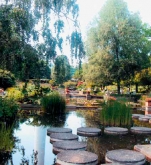Channels and Parks – this is Hamburg

The Free and Hanseatic City of Hamburg gained the prestigious European Green Capital 2011 title on the recommendation of a panel of environmental experts. They gave it top marks, ranking it above the 34 other European cities in the competition – no mean achievement. During the year, Hamburg has been turned a source of inspiration and ideas for sustainable development for both its inhabitants and residents of other cities.
The city of Hamburg, situated on the banks of the river Elbe, where it flows into the North Sea, has a population of about 1.8 million and faces numerous metropolitan challenges. However Germany’s second largest city combines comprehensive approaches, policy -commitment and the necessary funding needed to resolve these challenges. On the whole, it has an integrated and participative planning strategy and a strong commitment towards a “green” vision.
More than 8% of Hamburg’s busy with water - the entire city is cut by channels, for which it is called Venice of the North. On embankments many open areas equipped for a pleasant rest of the townspeople. The quality of local ambient air is very good, and there are well defined targets, excellent results, future plans and structured monitoring with respect to climate change. It should be mentioned that Hamburg has set ambitious climate protection goals such as reducing its CO2 emissions by 40% by 2020 and by 80% by the year 2050. CO2 emissions per person have been reduced by about 15% when compared to 1990, with annual energy savings of some 46,000 MWh, a major achievement for a big city.
Full version you can download here
 Text: Kira Ivanova
Text: Kira Ivanova


